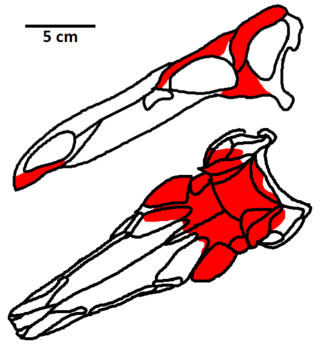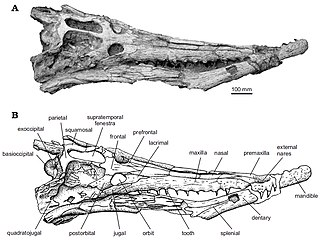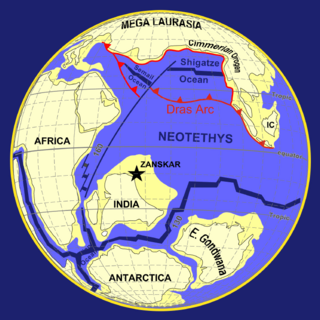Spencer George Lucas is an American paleontologist and stratigrapher, and curator of paleontology at the New Mexico Museum of Natural History and Science. His main areas of study are late Paleozoic, Mesozoic and early Cenozoic vertebrate fossils, stratigraphy, and continental deposits, particularly in the American Southwest. His research has taken him on field trips to northern Mexico, Costa Rica, Nicaragua, Jamaica, Kazakhstan, and Georgia, and he conducted extensive field and museum research in China in the 1980s and 1990s. He has written more than 500 scientific contributions, three books, and has co-edited 14 books.

Dravidosaurus is a controversial taxon of Late Cretaceous reptiles, variously interpreted as either a ornithischian dinosaur or a plesiosaur. The genus contains a single species, D. blanfordi, known from mostly poorly preserved fossils from the Coniacian of southern India.

The Lameta Formation, also known as the Infratrappean Beds, is a sedimentary geological formation found in Madhya Pradesh, Gujarat, Maharashtra, Telangana, and Andhra Pradesh, India, associated with the Deccan Traps. It is of the Maastrichtian age, and is notable for its dinosaur fossils.

Dyrosauridae is a family of extinct neosuchian crocodyliforms that lived from the Campanian to the Eocene. Dyrosaurid fossils are globally distributed, having been found in Africa, Asia, Europe, North America and South America. Over a dozen species are currently known, varying greatly in overall size and cranial shape. A majority were aquatic, some terrestrial and others fully marine, with species inhabiting both freshwater and marine environments. Ocean-dwelling dyrosaurids were among the few marine reptiles to survive the Cretaceous–Paleogene extinction event.

Dyrosaurus is a genus of extinct crocodylomorph that lived during the early Eocene. The name Dyrosaurus comes from sauros (σαῦρος) the Greek for lizard or reptile, and Dyr for Djebel Dyr (mountain) close to where the type species was discovered. It was a large reptile with an estimated body length of 6.5 metres (21 ft).

Apateodus is a genus of prehistoric marine ray-finned fish which was described by Woodward in 1901. It was a relative of modern lizardfish and lancetfish in the order Aulopiformes, and one of a number of prominent nektonic aulopiforms of Cretaceous marine ecosystems.
Kharmerungulatum is an extinct genus of herbivorous mammal from the Late Cretaceous (Maastrichtian) Intertrappean Beds of Madhya Pradesh, India. Its specific epithet honors Leigh Van Valen. It was described as one of the earliest known condylarths.
Parechelus is an extinct genus of prehistoric bony fish that lived during the Ypresian. The genus was circumscribed by Edgard Casier in 1967 for his description of P. parechelus.
Casierius is an extinct genus of marine ray-finned fish that lived during the Albian stage of the Early Cretaceous epoch. It was a relative of the modern bonefish in the extinct family Phyllodontidae, although some authorities consider it either a true albulid or a very early eel. It contains a single species, C. heckeli, known from the Glen Rose Formation near Hood County, Texas.
Eolamprogrammus is an extinct genus of prehistoric marine cusk-eel that lived during the earliest Eocene. It contains a single species, E. senectus from the earliest Ypresian-aged Danata Formation of Turkmenistan. It may potentially represent an early member of the Neobythitinae.

Dapalis is an extinct genus of prehistoric glassfish known from the Middle Eocene to the Early Miocene. It is known from both freshwater and estuarine habitats of much of mainland Europe.

Cylindracanthus is an extinct, enigmatic genus of marine ray-finned fish with fossils known throughout North America, Europe, Asia and Africa from the Late Cretaceous to the late Eocene, with potential Oligocene records and a possible Miocene record also known. It is exclusively known from its distinctive partial remains, which are long cylindrical bony spines that are usually considered rostrum fragments, as well as some associated teeth. These spines are abundant & widespread throughout this timespan, and are useful indicators of a nearshore marine environment, but the taxonomic identity of the fish is still highly uncertain and debated.
The Intertrappean Beds are a Late Cretaceous and early Paleogene geologic unit in India. These beds are found as interbeds between Deccan Traps layers, including the slightly older Lameta Formation. They consist a number of different subgroups and formations, and span the Cretaceous–Paleogene boundary.
The Takli Formation is a Maastrichtian geologic formation in India. Dinosaur remains diagnostic to the genus level are among the fossils that have been recovered from the formation.
Deccanolestes is a scansorial, basal Euarchontan from the Late Cretaceous (Maastrichtian) and Paleocene Intertrappean Beds of Andhra Pradesh, India. It may be closely related to Sahnitherium. Deccanolestes has been referred to Palaeoryctidae in the past, but recent evidence has shown that it is either the most basal Euarchontan, as the earliest known Adapisoriculid, or as a stem-afrotherian.
Gladioserratus is an extinct genus of cow shark. It contains three species:

Insular India was an isolated landmass which became the Indian subcontinent. Across the latter stages of the Cretaceous and most of the Paleocene, following the breakup of Gondwana, the Indian subcontinent remained an isolated landmass as the Indian Plate drifted across the Tethys Ocean, forming the Indian Ocean. The process of India's separation from Madagascar first began 88 million years ago, but complete isolation only occurred towards the end of the Maastrichtian, a process that has been suggested to be the creation of the Deccan Traps. Soon after, the land mass moved northward rather quickly, until contact with Asia was established 55 million years ago. Even then, both landmasses did not become fully united until around 35 million years ago, and periods of isolation occurred as recently as 24 million years ago.
Avashishta bacharamensis is an extinct genus of a possibly late surviving haramiyid from the Maastrichtian Lameta formation of India. It is known from a solitary molariform tooth. It might represent the last known non-mammalian synapsid.
Horaclupea is an extinct genus of freshwater and estuarine ray-finned fish that inhabited the Indian subcontinent during the early Eocene. It was a clupeoid, making it related to modern herrings and anchovies. It was named after Indian ichthyologist Sunder Lal Hora, who described the first species of the genus.
Lepisosteusindicus, the Indian gar, is an extinct species of gar known from the Late Cretaceous (Maastrichtian) and early Paleocene of India. It is known from a single articulated but poorly-preserved skull and a lost set of vertebrae from the Lameta Formation, in addition to numerous isolated scales and teeth from the Lameta Formation and Intertrappean Beds.







